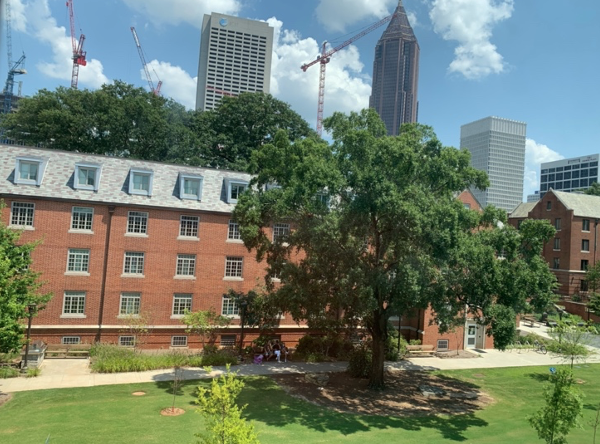When thinking about cities, what is the first image that pops into your head? Concrete buildings? Traffic for miles? The hustle and bustle of people living their daily lives? I’ll admit that these are the realities of most cities, but not mine. Here in Atlanta, we have the traffic, and we have the fast-paced movement, but what really makes Atlanta stand out from other cities is our trees. In a picture attached below taken from the Price Gilbert Memorial Library on Georgia Tech’s campus, one can easily see the beautiful canopy. Atlanta has long been dubbed “the city in a forest” due to its large amount of green space. Its skyline is marked with trees, as the canopy covers our lives. An estimated 48% or 40,524 acres of land is taken up by green spaces and nature. Not to mention that Atlanta has over 350 public parks which are also covered in trees. This is quite a stark difference to most other urban areas, where typically there isn’t a tree in sight other than the occasional park. Atlanta has the highest tree density of any of the major cities with Charlotte, North Carolina coming in second, and Chicago, Illinois in last. These cities have an obvious lack of trees, instead having scattered parks. Atlanta is lucky enough to have its large canopy in addition to its several parks.

The reason that Atlanta has the privilege to be “the city in a forest” is due to the later industrialization Atlanta compared to other cities. The south was focused on agriculture well into the time period when the north began to industrialize. Because of this, the south had their industrialization period almost half a century after the north began. This is also why the south has fewer big cities than the north. Atlanta began its ascendance to being a big city in the 1820s, long after many other cities were settled and introduced. Then Atlanta’s industrialization came even later in the mid 1900s, while the rise of civil rights brought a lot of attention to the area. Because it was industrialized so late, Atlanta was able to keep our natural abundance of trees all over the city. Even more interesting is that most of Atlanta’s canopy is native to this region. Most other cities have to import their green spaces to keep them flourishing.
The World Health Organization (WHO) estimates that almost 2/3 of the population in Europe lives in urban spaces now, highlighting the importance of having green spaces incorporated into urban development and planning. The pace of the city is captured perfectly in Ernst Ludwig Kirchner’s painting entitled Street, Dresden (attached below). Due to its high population, urban areas run higher risk for air pollution, noise pollution, and light pollution. Because of this, the WHO have begun to promote and encourage local officials to work toward having more conversations about nature in their cities. Green spaces not only help combat pollutants of all sorts, but also have shown to reduce stress and increase resilience in city-goers, thereby improving the quality of life in the city. When people are less exposed to pollutants, they have healthier lives in general. These areas also encourage healthier lifestyle habits like frequent exercise. People are more likely to get out and exercise in green spaces like parks than in building-heavy areas. I see tons of people exercising in Atlanta’s Piedmont Park, pictured below. A study done at the Netherlands Institute for Health Services Research showed that the number of green spaces within a person’s living radius had a significant impact on those people’s health.


In particular, green spaces are beneficial to underprivileged people in cities who are often the least likely to have access to these areas. There may be green, nature-rich areas in the higher-class neighborhoods, but no access to even a park in lower-class neighborhoods. Therefore, the lack of green places disproportionately affects the people in those neighborhoods. Sadly, this lack of access is applicable even to Atlanta despite its large acreage of trees. Continuing, if it’s bad even in “the city in a forest,” it is even worse in those without forestry. This exposes underprivileged communities to disproportionately large amounts of air, noise, and light pollution that can be combated with trees and green spaces. To fight this inequality, city officials and locals should fight to add green spaces not only to the city as a whole, but directly into poorer neighborhoods to decrease their exposure to these pollutants. Green spaces are often considered luxuries, but recent findings on their impact on health show that they should be considered necessities in all communities.
As a nation and all over the world, we lose thousands and thousands of acres of forest daily due to logging and general deforestation. This not only affects the biodiversity that lives in those area, but also us humans as we increase air pollution, while getting rid of our main source to solve air pollution. At the rate we are going, quality air is unsustainable. With forests only covering 30% of the Earth’s surface and dwindling fast, action needs to occur soon. Action can start in cities with less forestry with organization, such as the many in Atlanta, that fight for the planting of trees around cities.
In 2016, Atlanta passed an amendment called the “Tree Trust Fund” that allowed the city to buy up forested land around Atlanta, all while allowing free public access. This was done as an attempt to further protect Atlanta’s natural canopy. These nature-filled areas in Atlanta are being cared for by many non-profit organizations, allowing us to enjoy the break from the industrialized city. However, despite this, many trees around Atlanta are not protected by an ordinance, which could lead to a reduction of green spaces. The initiatives put in place protects land owned by the city, but not those in private hands. It is estimated that about 80% of the canopy actually lives in residential areas, which go unprotected. Atlanta is currently leading the nation in green spaces, but to stay that way, more measures must be put in place to protect and sustain the forestry we have. City in the forest, CITF, is a group of Atlanta residents concerned with creating new protections for the City’s canopy. With these groups in place, Atlanta’s canopy is hopefully in secure hands.
This all probably comes as no surprise if you have been to most big cities and then come to Atlanta. As a native Atlantian, I never realized how drastic the difference was until visiting Chicago. Chicago looks much like the painting by Charles Sheeler’s called Skyscrapers (attached below). I went from seeing trees all over my city to only seeing the occasional tree. Although Chicago is beautiful, I felt that the lack of trees really took away from the skyline and I missed my urban jungle. Then I began visiting college campuses around the United States and saw the difference more and more. I knew I wanted to go to school in a city, so I was vising cities like New York, Los Angeles, etc. I feared that being in a place without green spaces would hinder my motivation and harm my mental health, so I chose to stay in Atlanta and attend Georgia Tech. Even from my dorm room, I can see the beautiful green spaces provided. Here on our campus, we have tons of green space as well, which really makes it feel like our campus is separate from Atlanta as a whole. We have our own space. Georgia Tech puts huge emphasis on mental health which is why they attempt to provide so many green spaces for students. Our largest area being Tech Green which is a lovely area to have a picnic or swing in a hammock with friends. On the prettiest of days, Tech Green looks a lot like the painting in the park by Maurice Prendergast, People strolling, playing with animals, and enjoying the nice day. Even on this smaller scale of our campus within Atlanta’s borders, I have seen the beneficial results that the canopy has on students’ mental health. When students need a break from the academic rigor, you can often find them taking a walk through the green, playing soccer over at STAMPs field, or picnicking on the quad. My peers corroborate the idea that these green infrastructures reduce our stress overall. A good friend of mine decided to do most of her schoolwork outside on Tech Green because it helps her feel much calmer when working on her already stressful work. Personally, I have made the commitment to go outside to any of Tech’s campus’ green spaces to decompress during my harder weeks.


I have long wondered why other cities do not look to Atlanta as a role model in regard to our nature-based infrastructure, but it appears that many people do not see the benefits of having the green spaces that Atlanta does. However, if you were to leave your city, and enjoy a visit to Atlanta, I believe the difference would become quite apparent. On my college campus, there is something indescribable about the environment that Georgia Tech students create outside when the weather is nice. The sense of community is overwhelming as I watch students do work at the tables, play frisbee on the lawn, or nap in the sun. It becomes more obvious to be me by the day that green spaces not only benefit mental health and productive, but they help to promote a sense of community and unity in cities.

Sources
- https://www.atlantamagazine.com/list/life-atlanta-2040/still-the-city-of-trees/
- https://www.treesatlanta.org/news/a-city-in-the-forest-atlantas-effort-to-preserve-nature-in-the-city/
- https://www.euro.who.int/__data/assets/pdf_file/0010/342289/Urban-Green-Spaces_EN_WHO_web3.pdf%3Fua=1#:~:text=Green%20space%20interventions%20have%20been,physical%20and%20mental%20well%2Dbeing
- https://saportareport.com/atlantas-urban-tree-canopy-leads-nation-trees-not-protected/columnists/maria_saporta/
- https://patch.com/georgia/midtown/why-atlanta-city-forest

I really enjoyed reading your blog post! I knew that Atlanta was more “green” than other cities, but I had no idea how much of a distinction there is from all of the major cities in the U.S.! I appreciated that you included your own experience as evidence, and I liked how you made an argument to preserve green space while admiring the efforts that the city of Atlanta is currently making. In my blog post, I talked about how the presence of street art makes Atlanta seem more welcoming than other cities, and I can definitely see how green space has the same effect!